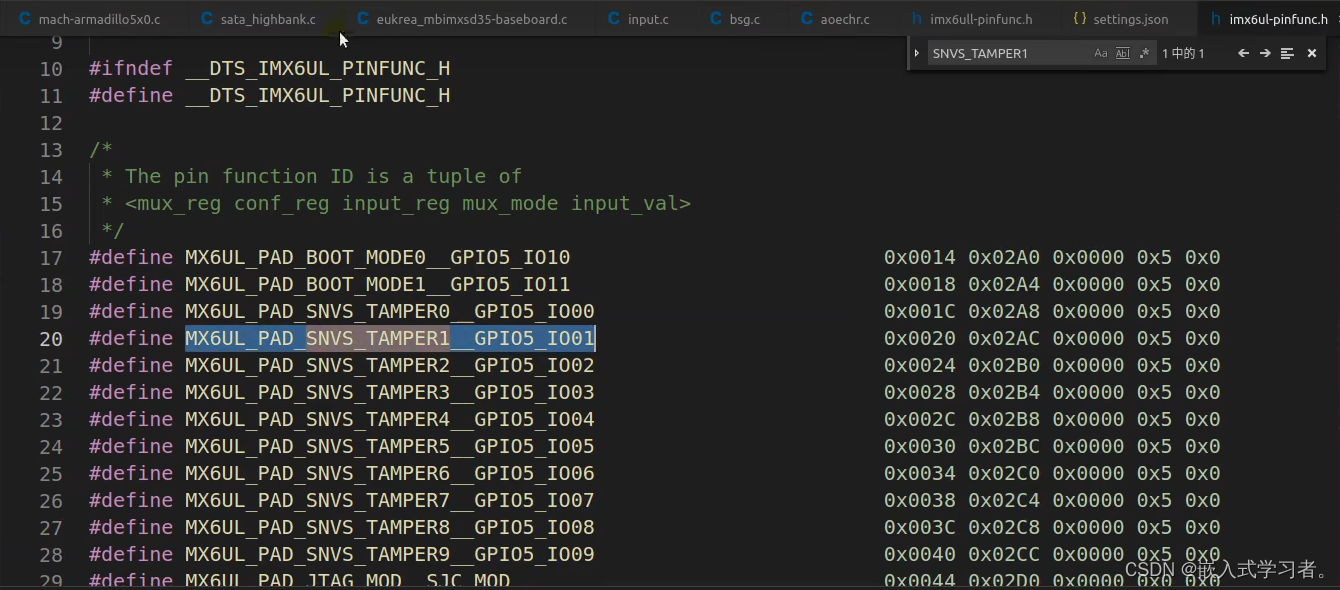一、添加设备树
1、查看原理图,蜂鸣器引脚是SNVS TAMPER4

2、查看imx6ull参考手册看寄存器配置

3、添加设备树节点
在
imx6ul-pinfunc或imx6ull-pinfunc.h
中找到管脚定义,复制到设备树pinctrl节点。(注:6ul和6ull寄存器地址可能不同)

在设备树中添加

创建蜂鸣器节点

make dtbs //编译设备树,然后拷贝设备树到tftp目录下
在开发板上看beep驱动是否存在

驱动程序
#include <linux/types.h>
#include <linux/kernel.h>
#include <linux/delay.h>
#include <linux/ide.h>
#include <linux/init.h>
#include <linux/module.h>
#include <linux/errno.h>
#include <linux/gpio.h>
#include <linux/cdev.h>
#include <linux/device.h>
#include <linux/of.h>
#include <linux/of_address.h>
#include <linux/of_gpio.h>
#include <asm/mach/map.h>
#include <asm/uaccess.h>
#include <asm/io.h>
#define BEEP_CNT 1 /* 设备号个数 */
#define BEEP_NAME "beep" /* 名字 */
#define BEEPOFF 0 /* 关蜂鸣器 */
#define BEEPON 1 /* 开蜂鸣器 */
/* beep设备结构体 */
struct beep_dev{
dev_t devid; /* 设备号 */
struct cdev cdev; /* cdev */
struct class *class; /* 类 */
struct device *device; /* 设备 */
int major; /* 主设备号 */
int minor; /* 次设备号 */
struct device_node *nd; /* 设备节点 */
int beep_gpio; /* beep所使用的GPIO编号 */
};
struct beep_dev beep; /* beep设备 */
/*
* @description : 打开设备
* @param - inode : 传递给驱动的inode
* @param - filp : 设备文件,file结构体有个叫做private_data的成员变量
* 一般在open的时候将private_data指向设备结构体。
* @return : 0 成功;其他 失败
*/
static int beep_open(struct inode *inode, struct file *filp)
{
filp->private_data = &beep; /* 设置私有数据 */
return 0;
}
/*
* @description : 向设备写数据
* @param - filp : 设备文件,表示打开的文件描述符
* @param - buf : 要写给设备写入的数据
* @param - cnt : 要写入的数据长度
* @param - offt : 相对于文件首地址的偏移
* @return : 写入的字节数,如果为负值,表示写入失败
*/
static ssize_t beep_write(struct file *filp, const char __user *buf, size_t cnt, loff_t *offt)
{
int retvalue;
unsigned char databuf[1];
unsigned char beepstat;
struct beep_dev *dev = filp->private_data;
retvalue = copy_from_user(databuf, buf, cnt);
if(retvalue < 0) {
printk("kernel write failed!\r\n");
return -EFAULT;
}
beepstat = databuf[0]; /* 获取状态值 */
if(beepstat == BEEPON) {
gpio_set_value(dev->beep_gpio, 0); /* 打开蜂鸣器 */
} else if(beepstat == BEEPOFF) {
gpio_set_value(dev->beep_gpio, 1); /* 关闭蜂鸣器 */
}
return 0;
}
/*
* @description : 关闭/释放设备
* @param - filp : 要关闭的设备文件(文件描述符)
* @return : 0 成功;其他 失败
*/
static int beep_release(struct inode *inode, struct file *filp)
{
return 0;
}
/* 设备操作函数 */
static struct file_operations beep_fops = {
.owner = THIS_MODULE,
.open = beep_open,
.write = beep_write,
.release = beep_release,
};
/*
* @description : 驱动出口函数
* @param : 无
* @return : 无
*/
static int __init beep_init(void)
{
int ret = 0;
/* 设置BEEP所使用的GPIO */
/* 1、获取设备节点:beep */
beep.nd = of_find_node_by_path("/beep");
if(beep.nd == NULL) {
printk("beep node not find!\r\n");
return -EINVAL;
} else {
printk("beep node find!\r\n");
}
/* 2、 获取设备树中的gpio属性,得到BEEP所使用的BEEP编号 */
beep.beep_gpio = of_get_named_gpio(beep.nd, "beep-gpios", 0);
if(beep.beep_gpio < 0) {
printk("can't get beep-gpio");
return -EINVAL;
}
printk("led-gpio num = %d\r\n", beep.beep_gpio);
/* 3、设置GPIO5_IO01为输出,并且输出高电平,默认关闭BEEP */
ret = gpio_direction_output(beep.beep_gpio, 1);
if(ret < 0) {
printk("can't set gpio!\r\n");
}
/* 注册字符设备驱动 */
/* 1、创建设备号 */
if (beep.major) { /* 定义了设备号 */
beep.devid = MKDEV(beep.major, 0);
register_chrdev_region(beep.devid, BEEP_CNT, BEEP_NAME);
} else { /* 没有定义设备号 */
alloc_chrdev_region(&beep.devid, 0, BEEP_CNT, BEEP_NAME); /* 申请设备号 */
beep.major = MAJOR(beep.devid); /* 获取分配号的主设备号 */
beep.minor = MINOR(beep.devid); /* 获取分配号的次设备号 */
}
printk("beep major=%d,minor=%d\r\n",beep.major, beep.minor);
/* 2、初始化cdev */
beep.cdev.owner = THIS_MODULE;
cdev_init(&beep.cdev, &beep_fops);
/* 3、添加一个cdev */
cdev_add(&beep.cdev, beep.devid, BEEP_CNT);
/* 4、创建类 */
beep.class = class_create(THIS_MODULE, BEEP_NAME);
if (IS_ERR(beep.class)) {
return PTR_ERR(beep.class);
}
/* 5、创建设备 */
beep.device = device_create(beep.class, NULL, beep.devid, NULL, BEEP_NAME);
if (IS_ERR(beep.device)) {
return PTR_ERR(beep.device);
}
return 0;
}
/*
* @description : 驱动出口函数
* @param : 无
* @return : 无
*/
static void __exit beep_exit(void)
{
/* 注销字符设备驱动 */
cdev_del(&beep.cdev);/* 删除cdev */
unregister_chrdev_region(beep.devid, BEEP_CNT); /* 注销设备号 */
device_destroy(beep.class, beep.devid);
class_destroy(beep.class);
}
module_init(beep_init);
module_exit(beep_exit);
MODULE_LICENSE("GPL");
MODULE_AUTHOR("hsd");
app
#include "stdio.h"
#include "unistd.h"
#include "sys/types.h"
#include "sys/stat.h"
#include "fcntl.h"
#include "stdlib.h"
#include "string.h"
#define BEEPOFF 0
#define BEEPON 1
/*
* @description : main主程序
* @param - argc : argv数组元素个数
* @param - argv : 具体参数
* @return : 0 成功;其他 失败
*/
int main(int argc, char *argv[])
{
int fd, retvalue;
char *filename;
unsigned char databuf[1];
if(argc != 3){
printf("Error Usage!\r\n");
return -1;
}
filename = argv[1];
/* 打开beep驱动 */
fd = open(filename, O_RDWR);
if(fd < 0){
printf("file %s open failed!\r\n", argv[1]);
return -1;
}
databuf[0] = atoi(argv[2]); /* 要执行的操作:打开或关闭 */
/* 向/dev/beep文件写入数据 */
retvalue = write(fd, databuf, sizeof(databuf));
if(retvalue < 0){
printf("BEEP Control Failed!\r\n");
close(fd);
return -1;
}
retvalue = close(fd); /* 关闭文件 */
if(retvalue < 0){
printf("file %s close failed!\r\n", argv[1]);
return -1;
}
return 0;
}
版权声明:本文为afddasfa原创文章,遵循 CC 4.0 BY-SA 版权协议,转载请附上原文出处链接和本声明。